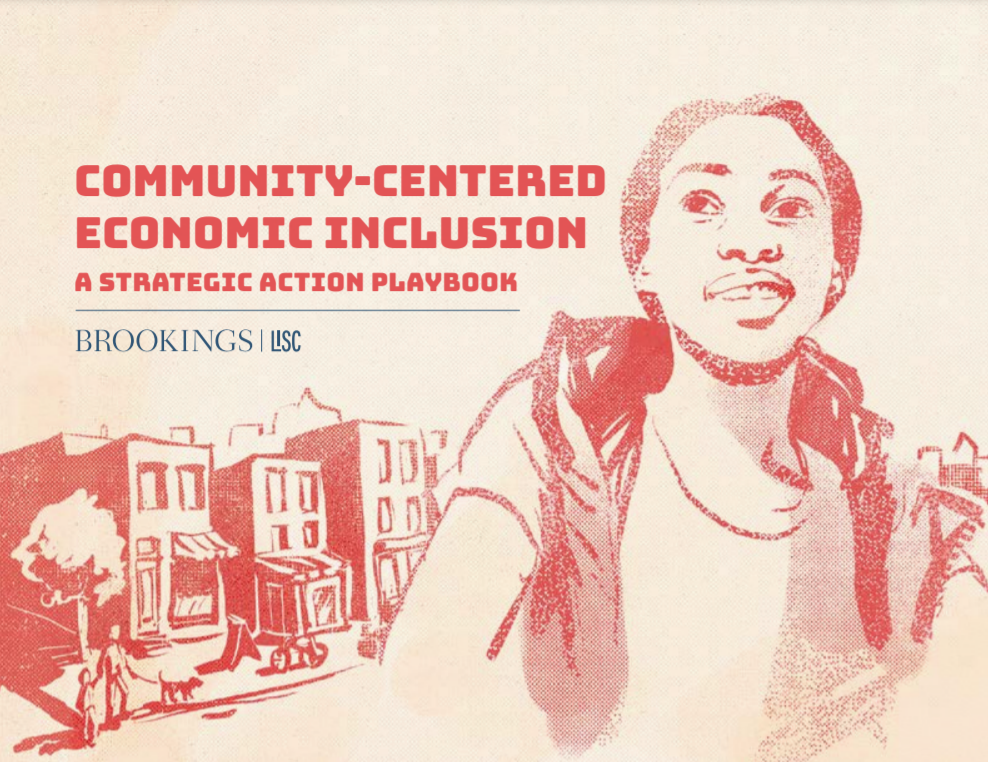In a new playbook co-authored with Brookings, William Taft, LISC’s SVP of Economic Development, and Program Director Elizabeth Demetriou outline the conditions for inclusive economic development in long-underinvested industrial corridors and business districts. Strategic investment in such places, they argue in the following blog, creates a positive ripple effect for local residents, businesses and ultimately the regional economy, and that’s just the beginning.
Graphic design by Cecily Anderson, anagramist.com.
In LISC’s four decades of work, we have come to understand that in order to promote inclusive growth in communities, we must identify and invest in business districts where inequities relative to the surrounding city or region have stymied those places and kept them from kindling opportunities for their workers and residents. This kind of investment, when it is anchored in and led by a community’s own expertise and assets, can create meaningful change for both consumers and employees in commercial and industrial districts that have long been overlooked and under-resourced. Change that in turn has repercussions for the wellbeing of local people and a region’s workforce and economy as a whole.
“Community-Centered Economic Inclusion: A Strategic Action Playbook,” a new joint publication by LISC and Brookings, provides concrete guidance for practitioners, residents and city and regional leaders to carry out a community-centered economic inclusion work that helps build wealth and opportunity in such places, while driving city and regional economic growth and development that centers equity at its core. The playbook offers lessons from three LISC markets—Indianapolis, Los Angeles, and Philadelphia—cities where we piloted the framework between fall 2019 and winter 2021. (Our work in Los Angeles was described in another report LISC co-authored with Brookings last fall, No More Status Quo: A Community-Led Action Plan for Addressing Structural Inequity During COVID-19 Recovery.)
As we and our co-authors demonstrate, community-centered economic inclusion has three distinctive features that we believe makes it uniquely effective:
- It invests limited resources at a targeted, strategic scale—bolstered by data, local knowledge, and community buy-in—focusing on districts within cities and towns that have the potential to generate economic benefits for underinvested communities, and at the same time make city and regional economic development more equitable.
- Its multidisciplinary, systems-level scope brings together the community, economic and workforce development fields to nurture long-overdue investment in people and places, and connect residents and small businesses to their regional economies.
- Its emphasis on integration mobilizes leaders at the city and regional level, together with communities most affected by structural inequities, to develop shared priorities for place-based investment and economic development.
The playbook presents a five-step plan that community, city, and regional leaders across the country can use to inform and implement their own community-centered economic inclusion work.
The early outcomes, while heavily shaped by the impact of the COVID-19 pandemic, are nevertheless very encouraging: pilot cities have been able to leverage the partnerships they built during the agenda-setting process to advance COVID-19 relief and recovery efforts. For example, partners helped direct LISC small business cash grants locally, and were well positioned to raise money for local grant pools. They also provided direct technical support to small businesses, helping them navigate programs like the Paycheck Protection Program, and they made investments in Business Development Organizations (BDOs) that provided culturally competent services to entrepreneurs in the community.
Building on lessons learned from the pilot, LISC is scaling this work in more communities to drive inclusive recovery and growth. The work in our playbook takes the long view, and demands a commitment to patient collaboration and strategic investment to create authentic, lasting strength for people and their communities. We are excited to be part of this, and to see community-rooted economic inclusion blossom and flourish. Now, in the wake of Covid, and well beyond.

This playbook provides local leaders with an actionable set of tools to create more just landscapes of neighborhood opportunity through community-centered economic inclusion—a new, multidisciplinary and systems-level approach to building community wealth within underinvested places, while driving city and regional economic growth and development that centers equity at its core.
About the Authors
 Bill Taft, Senior Vice President of Economic Development
Bill Taft, Senior Vice President of Economic Development
Bill leads the expansion of LISC’s inclusive economic development efforts in its 37 local programs by investing in people, places, and businesses. Bill has been with LISC since 2005, initially serving as LISC Indianapolis’ Executive Director, later as Program Vice President, and now as Senior Vice President for Economic Development. Under Bill’s leadership, LISC Indianapolis invested over $240 million to leverage $1 billion of investment in the core urban neighborhoods of Indianapolis. Prior to that, Bill was President of Southeast Neighborhood Development, Inc. (SEND) for 14 years, overseeing the early phases of revitalizing the Fountain Square area of Indianapolis. Bill holds an undergraduate degree from Cedarville University and a master’s from Ball State University’s College of Architecture and Planning.
 Elizabeth Demetriou, AICP
National Director of Economic Development
Elizabeth Demetriou, AICP
National Director of Economic Development
Elizabeth supports initiatives that contribute to the revival of disinvested business districts and advance inclusive economic development. Prior to joining LISC, Elizabeth was Deputy Director of the NYC Regional Economic Development Council at Empire State Development Corporation (ESD). A member of the American Institute of Certified Planners (AICP), she has a Master’s of Urban Planning from Hunter College (CUNY) and is on the board of the Urban Manufacturing Alliance.
@EODemetriou
